An online project under the direction of the CAPE ANN MUSEUM
inv. 268
The Yacht "Northern Light" in Boston Harbor
1845 Oil on canvas 17 1/2 x 25 11/16 in. (44.4 x 65.2 cm) Signed, inscribed, and dated verso: Painted by F.H. Lane from a sketch by / Salmon / 1845
|
Explore catalog entries by keywords view all keywords »
Historical Materials
Below is historical information related to the Lane work above. To see complete information on a subject on the Historical Materials page, click on the subject name (in bold and underlined).
During the years after the war of 1812 and before the Civil War, the port of Boston was a center of American deep-water shipping. Trading with China, India, and the West Indies, which had fueled maritime growth in the early years of the century gave way to re-exporting these goods and foreign trade based on the shoe and textile trades. Although second to New York in terms of shipping tonnage, many of New York's shipbuilders and merchants were Boston based. In addition, ship building continued in Boston. Also, the coastal trade (the domestic trade up and down the coast) was still the most efficient way to transport goods and passengers, and accounts for much of the tonnage and shipping traffic.
Although dwarfed by New York, Boston was an active port in the 1840s and 1850s. Its registered tonnage rose from 149,186 in 1840 to 270,510 in 1850. The harbor was a crowded place. For example, on September 18, 1850, 32 ships, 49 barks, 47 brigs, and 52 schooners were reported at Boston.(1)
In 1849, foreign entries at Boston included 215 ships, 305 barks, 908 brigs, and 52 schooners. Coastwise arrivals included 193 ships, 488 barks, 1087 brigs, 4287 schooners, 89 sloops, and 65 schooners.(2)
(1) W.H. Bunting, p.8.
(2) Ibid.
For more information:
Samuel Eliot Morrison, The Maritime History of Massachusetts, 1783-1860
W.H. Bunting, Portrait of a Port, Boston 1852-1914 Cambridge: The Belknap Press of Harvard University, 1971.
Printed map inside Boston Almanac
Published by B. B. Mussey & Co. and Thomas Groom, Boston
Cape Ann Museum Library & Archive (R910.45 B65 1848)
Map at front of almanac with Tremont Temple highlighted.
Also filed under: Boston City Views » // Maps » // Tremont Temple »
Harvard Depository: Widener (NAV 578.57)
For digitized version, click here.
Also filed under: Signal Systems (Flags & Maritime Codes) »
Tinted lithograph with hand coloring
13 7/8 x 22 3/8 in.
Boston Athenaeum
From Sally Pierce and Catharina Slautterback, Boston Lithography, 1825–1880: The Boston Atheneaum Collection (Boston: Athenaeum, 1991): "Tidd drew this print when he was a consulting engineer for Simpson's. He has depicted the clipper ship 'Southern Cross' in the dry dock. Built in 1851, she was known for having sailed from San Francisco to Hong Kong in the record breaking time of thirty-two days. The Bethlehem Ship Building Company eventually took over this location and operated a dry dock there until the mid 1940s."
Also filed under: "Southern Cross" (Clipper Ship) » // M. M. Tidd, Lith. – Boston »
Library of Congress Catalog Number 2004671768
Also filed under: "Britannia" (Cunard Steamship) »
1853
Bostonian Society (1884.0209)
Also filed under: Scott, John W. A. »
1 print : lithograph, tinted ; image 50.3 x 111.9 cm., 68.7 x 121.2 cm.
View of the city of Boston from East Boston showing Boston Harbor. The wharves of East Boston can be seen in the foreground.
Number nine of thirty-eight city views published in "Whitefield's Original Views of (North) American Cities (Scenery).
On stone by Charles W. Burton after a drawing by Edwin Whitefield.
Inscribed in brown ink lower right corner of sheet: "Boston Athenaeum from Josiah Quincy. September 28, 1848."
Local Notes:#1848.1.
The schooner yacht "Northern Light" was designed by Louis Winde for Colonel William P. Winchester and built by Whitmore Holbrook at East Boston in 1839. She was sold in 1846 for use as a packet between Boston and Plymouth, Massachusetts. She was re-purchased by Winchester in 1848 who sold her in the following year, and was then used to take prospectors to California during the Gold Rush. She was driven ashore in the Magellan Straits and lost in March 1850.
– Erik Ronnberg
See p. 163.
Also filed under: Yacht & Small Pleasure Craft »
The Rudder Vol. XV Part 1–3; pp. 387–390, 456–460, 483–486
"Historic American Yachts: Early Boston Vessels, The Northern Light and Coquette."
Also filed under: Yacht & Small Pleasure Craft »
wood, metal, cordage
Model of schooner yacht "Northern Light" of Boston, 1839
Scale 1:32
Also filed under: Ship Models » // Yacht & Small Pleasure Craft »
wood, metal, cordage
Model of schooner yacht "Northern Light" of Boston, 1839
Scale 1:32
Also filed under: Yacht & Small Pleasure Craft »
unidentified newspaper clipping
16 October 1846
Robert Bennet Forbes Scrapbook
volume 1, p.55
Phillips Library, Peabody Essex Museum (SCR 4)
Also filed under: New-York Yacht Club » // Regattas »
The colonial American shallop is the ancestor of many regional types of New England fishing craft found in Lane's paintings and drawings, including "New England Boats" (known as "boats" and discussed elsewhere), and later descendents, such as "Chebacco Boats," "Dogbodies," and "Pinkies."
These boats were very common work boat types on Cape Ann throughout the 1800s. They were primarily used for inshore coastal fishing, which included lobstering, gill-netting, fish-trapping, hand-lining, and the like. They were usually sailed by one or two men, sometimes with a boy, and could be rowed as well as sailed. An ordinary catch would include rock cod, flounder, fluke, dabs, or other small flat fish. The catch would be eaten fresh, or salted and stored for later consumption, or used as bait fish. Gill-netting would catch herring and alewives when spawning. Wooden lobster traps were marked with buoys much as they are today, and hauled over the low sides of the boat, emptied of lobsters and any by-catch, re-baited and thrown back.
CHEBACCO BOATS AND PINKIES
In the Chebacco Parish of the Ipswich Colony, a larger version of the colonial shallop evolved to a heavily built two-masted boat with either a sharp or square stern. This development included partial decking at bow and stern, the former as a cuddy which was fitted with crude bunks and a brick fireplace for cooking. Further development provided midship decking over a fish hold with standing rooms fore and aft for fishing. At this stage, low bulwarks replaced simple rails and in the double-enders were extended aft beyond the rudderhead to form a “pinched,” or “pink“ stern. Some time in the second half of the eighteenth century, boats with these characteristics became known as Chebacco Boats. The squarestern versions were called Dogbodies, for reasons now forgotten. (1)
Chebacco Boats became the vessels of choice for Cape Ann fishermen working coastal grounds for cod, mackerel, herring, and groundfish with hook and line or with nets. This did not prevent them from venturing further, particularly in pursuit of migrating schools of mackerel. The “Bashalore,” a corruption of the Bay of Chaleur in the Gulf of St. Lawrence, was a favorite destination for Cape Ann Fishermen who fished for mackerel in that region. (2)
Lane undoubtedly saw Chebacco Boats in the years prior to his move to Boston, but if he made drawings or paintings of them in that period, none have come to light. A small lithograph, titled “View of the Old Fort and Harbor 1837,” is attributed to him, but the vessels and wharf buildings are too crudely drawn to warrant this undocumented claim. (3) Lane did see and render accurately the Chebacco Boat’s successor the Pinky—which was larger and had a schooner rig (two masts, main sail, fore sail, jib, and main topmast staysail).
Schooners with pinksterns were recorded early in the 18th century later that there were models and graphic representations of hull form and rig (Ref. 4). By then, the pinky was very similar in hull form to Chebacco Boats, and some Chebacco Boats were converted to pinkies by giving them schooner rigs. A pinky in Lane’s The Old Fort and Ten Pound Island, Gloucester, 1850s (inv. 30) (misdated 1850s, more likely mid-1840s) is quite possibly an example of such a conversion.
Lane’s depictions of pinkies in Massachusetts waters are numerous and sometimes very informative. Examples in his views of Gloucester Harbor portray them at various angles, from broadside (see Gloucester Harbor from Rocky Neck, 1844 (inv. 14), The Old Fort and Ten Pound Island, Gloucester, 1850s (inv. 30), and View of the Town of Gloucester, Mass., 1836 (inv. 86)) to stern (see The Western Shore with Norman's Woe, 1862 (inv. 18), The Old Fort and Ten Pound Island, Gloucester, 1850s (inv. 30), and Gloucester Harbor, 1850s (inv. 391)), but few, if any, bow views. His portrayals of pinkies in Boston Harbor and vicinity are more in the foreground and more generous in detail. The earliest of these, from 1845, shows a pinky getting underway in a hurry as the yacht "Northern Light" bears down on her in The Yacht "Northern Light" in Boston Harbor, 1845 (inv. 268). A late harbor view (id ) offers a rare bow view.
Like the Chebacco Boat, the pinky was primarily a fishing vessel, doing much the same kind of fishing in coastal waters, but large enough to venture further offshore to work on the banks in the Gulf of Maine in pursuit of the cod. By the 1820s, pinkies reached their largest size: 50 to 60 feet on deck. Beyond that size called for a different deck arrangement and higher rails, so men could stand on deck and fish from the rails – an arrangement offered by the banks fishing schooner. (5)
What is perhaps Lane’s most detailed and narrative view of a pinky appears in Becalmed Off Halfway Rock, 1860 (inv. 344) and dominates the right foreground. Fitted-out for mackerel gillnetting, she has a dory and a wherry in tow, the latter with the net in the stern. The crew is relaxed, enjoying the evening calm as the vessel heads for port. The barrels on deck are filled with freshly caught mackerel, which will be sold as such when landed, most likely at Gloucester. This pinky was probably fishing on Stellwagen Bank or Cape Cod Bay, which were good fishing grounds for mackerel, and close enough to Gloucester to make trips in smaller vessels worthwhile. To judge from his paintings, Lane found only a few pinkies in the parts of the Maine Coast he explored. Only one drawing (Southwest Harbor, Mount Desert, 1852 (inv. 184)) and two widely published paintings (Entrance of Somes Sound, Mount Desert, Maine, 1855 (inv. 347) and Bar Island and Mt. Desert Mountains from Somes Settlement, 1850 (inv. 401)) illustrate this type, and then at a distance. What is apparent is that pinkies in southern Maine did not differ markedly from those on the Massachusetts coast. Had Lane ventured further Down East, he might have found modifications to the type that reflected Canadian influences. (6)
– Erik Ronnberg
References:
1. William A. Baker, Sloops & Shallops (Barre, MA: Barre Publishing Co., 1966), 82–91; and Howard I. Chapelle, The American Fishing Schooners, 1825–1935 (New York: W.W. Norton & Co., 1973), 25–27.
2. G. Brown Goode, The Fisheries and Fishery Industries of the United States, Section V, Vol. I (Washington, DC: Government Printing Office, 1884–87), 275, 287, 298–300, 419–21, 425–32, 459–63.
3. John J. Babson, History of the Town of Gloucester, Cape Ann (Procter Bros., 1860, reprint: Gloucester, MA: Peter Smith, 1972), see lithograph facing p. 474.
4. Goode, 275–77, 280, 294–96.
5. Chapelle, 36–37.
6. Ibid., 45–54.
Glass plate negative
3 x 4 in.
Cape Ann Museum Library & Archive
#10112
Also filed under: Gloucester Harbor, Inner / Harbor Cove »
Also filed under: Ship Models »
Also filed under: Ship Models »
Also filed under: Ship Models » // Small Craft – Wherries, and Dories »
20" l. x 19" h. x 3 3/4" w. [not to scale]
Cape Ann Museum. Gift of Mr. J. Hollis Griffin, 1940 (891)
"Pinkys" were early nineteenth-century schooner-rigged derivations of Chebacco boats. This model is a good example of a traditional “sailor’s model,” or in this case, a sailmaker’s model, Mr. Nickerson having been a sailmaker.
Also filed under: Ship Models »
In John J. Babson, History of the Town Gloucester (Gloucester, MA: Procter Brothers, 1860)
Cape Ann Museum Library & Archives, Gloucester, Mass.
See p. 474.
View related Fitz Henry Lane catalog entries (2) »
Also filed under: Babson History of the Town of Gloucester » // Fort (The) and Fort Point » // Gloucester Harbor, Inner / Harbor Cove » // Gloucester, Mass. - "Ten Pound Island Light » // Schooner (Coasting / Lumber / Topsail / Packet / Marsh Hay) » // Ten Pound Island »
Schooners in Lane’s time were, with few exceptions, two-masted vessels carrying a fore-and-aft rig having one or two jibs, a fore staysail, gaff-rigged fore- and main sails, and often fore- and main topsails. One variant was the topsail schooner, which set a square topsail on the fore topmast. The hulls of both types were basically similar, their rigs having been chosen for sailing close to the wind. This was an advantage in the coastal trade, where entering confined ports required sailing into the wind and frequent tacking. The square topsail proved useful on longer coastwise voyages, the topsail providing a steadier motion in offshore swells, reducing wear and tear on canvas from the slatting of the fore-and-aft sails. (1)
Schooners of the types portrayed by Lane varied in size from 70 to 100 feet on deck. Their weight was never determined, and the term “tonnage” was a figure derived from a formula which assigned an approximation of hull volume for purposes of imposing duties (port taxes) on cargoes and other official levies. (2)
Crews of smaller schooners numbered three or four men. Larger schooners might carry four to six if a lengthy voyage was planned. The relative simplicity of the rig made sail handling much easier than on a square-rigged vessel. Schooner captains often owned shares in their vessels, but most schooners were majority-owned by land-based firms or by individuals who had the time and business connections to manage the tasks of acquiring and distributing the goods to be carried. (3)
Many schooners were informally “classified” by the nature of their work or the cargoes they carried, the terminology coined by their owners, agents, and crews—even sometimes by casual bystanders. In Lane’s lifetime, the following terms were commonly used for the schooner types he portrayed:
Coasting schooners: This is the most general term, applied to any merchant schooner carrying cargo from one coastal port to another along the United States coast (see Bar Island and Mt. Desert Mountains from Somes Settlement, 1850 (inv. 401), right foreground). (4)
Packet schooners: Like packet sloops, these vessels carried passengers and various higher-value goods to and from specific ports on regular schedules. They were generally better-maintained and finished than schooners carrying bulk cargoes (see The Old Fort and Ten Pound Island, Gloucester, 1850s (inv. 30), center; and Gloucester Inner Harbor, 1850 (inv. 240), stern view). (5)
Lumber schooners: Built for the most common specialized trade of Lane’s time, they were fitted with bow ports for loading lumber in their holds (see View of Southwest Harbor, Maine: Entrance to Somes Sound, 1852 (inv. 260)) and carried large deck loads as well (Stage Rocks and the Western Shore of Gloucester Outer Harbor, 1857 (inv. 8), right). Lumber schooners intended for long coastal trips were often rigged with square topsails on their fore masts (see Becalmed Off Halfway Rock, 1860 (inv. 344), left; Maverick House, 1835 (not published); and Lumber Schooner in a Gale, 1863 (inv. 552)). (6)
Schooners in other specialized trades. Some coasting schooners built for carrying varied cargoes would be used for, or converted to, special trades. This was true in the stone trade where stone schooners (like stone sloops) would be adapted for carrying stone from quarries to a coastal destination. A Lane depiction of a stone schooner is yet to be found. Marsh hay was a priority cargo for gundalows operating around salt marshes, and it is likely that some coasting schooners made a specialty of transporting this necessity for horses to urban ports which relied heavily on horses for transportation needs. Lane depicted at least two examples of hay schooners (see Gloucester Harbor, 1850s (inv. 391), left; and Coasting Schooner off Boon Island, c.1850 (inv. 564)), their decks neatly piled high with bales of hay, well secured with rope and tarpaulins.
– Erik Ronnberg
References:
1. Howard I. Chapelle, The History of American Sailing Ships (New York: W.W. Norton & Co., 1935), 258. While three-masted schooners were in use in Lane’s time, none have appeared in his surviving work; and Charles S. Morgan, “New England Coasting Schooners”, The American Neptune 23, no. 1 (DATE): 5–9, from an article which deals mostly with later and larger schooner types.
2. John Lyman, “Register Tonnage and its Measurement”, The American Neptune V, nos. 3–4 (DATE). American tonnage laws in force in Lane’s lifetime are discussed in no. 3, pp. 226–27 and no. 4, p. 322.
3. Ship Registers of the District of Gloucester, Massachusetts, 1789–1875 (Salem, MA: The Essex Institute, 1944). Vessels whose shipping or fishing voyages included visits to foreign ports were required to register with the Federal Customs agent at their home port. While the vessel’s trade or work was unrecorded, their owners and master were listed, in addition to registry dimensions and place where built. Records kept by the National Archives can be consulted for information on specific voyages and ports visited.
4. Howard I. Chapelle, The National Watercraft Collection (Washington, DC: Smithsonian Institution, 1960), 40, 42–43.
5. Ibid., 42–43, 73.
6. Ibid., 74–76.
A topsail schooner has no tops at her foremast, and is fore-and-aft rigged at her mainmast. She differs from an hermaphrodite brig in that she is not properly square-rigged at her foremast, having no top, and carrying a fore-and-aft foresail instead of a square foresail and a spencer.
Wood rails, metal rollers, chain; wood cradle. Scale: ½" = 1' (1:24)
Original diorama components made, 1892; replacements made, 1993.
Cape Ann Museum, from Gloucester Chamber of Commerce, 1925 (2014.071)
A schooner is shown hauled out on a cradle which travels over racks of rollers on a wood and metal track.
Also filed under: Burnham Brothers Marine Railway » // Marine Railways »
Glass plate negative
Collection of Erik Ronnberg
Also filed under: Lobstering »
Details about Maine's lumber trade in 1855, see pp. 250–52
Also filed under: Castine » // Lumber Industry »
The term "ship," as used by nineteenth-century merchants and seamen, referred to a large three-masted sailing vessel which was square-rigged on all three masts. (1) In that same period, sailing warships of the largest classes were also called ships, or more formally, ships of the line, their size qualifying them to engage the enemy in a line of battle. (2) In the second half of the nineteenth century, as sailing vessels were replaced by engine-powered vessels, the term ship was applied to any large vessel, regardless of propulsion or use. (3)
Ships were often further defined by their specialized uses or modifications, clipper ships and packet ships being the most noted examples. Built for speed, clipper ships were employed in carrying high-value or perishable goods over long distances. (4) Lane painted formal portraits of clipper ships for their owners, as well as generic examples for his port paintings. (5)
Packet ships were designed for carrying capacity which required some sacrifice in speed while still being able to make scheduled passages within a reasonable time frame between regular destinations. In the packet trade with European ports, mail, passengers, and bulk cargos such as cotton, textiles, and farm produce made the eastward passages. Mail, passengers (usually in much larger numbers), and finished wares were the usual cargos for return trips. (6) Lane depicted these vessels in portraits for their owners, and in his port scenes of Boston and New York Harbors.
Ships in specific trades were often identified by their cargos: salt ships which brought salt to Gloucester for curing dried fish; tea clippers in the China Trade; coffee ships in the West Indies and South American trades, and cotton ships bringing cotton to mills in New England or to European ports. Some trades were identified by the special destination of a ship’s regular voyages; hence Gloucester vessels in the trade with Surinam were identified as Surinam ships (or barks, or brigs, depending on their rigs). In Lane’s Gloucester Harbor scenes, there are likely (though not identifiable) examples of Surinam ships, but only the ship "California" in his depiction of the Burnham marine railway in Gloucester (see Three Master on the Gloucester Railways, 1857 (inv. 29)) is so identified. (7)
– Erik Ronnberg
References:
1. R[ichard)] H[enry] Dana, Jr., The Seaman’s Friend, 13th ed. (Boston: Thomas Groom & Co., 1873), p. 121 and Plate IV with captions.
2. A Naval Encyclopaedia (Philadelphia: L. R. Hamersly & Co., 1884), 739, 741.
3. M.H. Parry, et al., Aak to Zumbra: A Dictionary of the World’s Watercraft (Newport News, VA: The Mariners’ Museum, 2000), 536.
4. Howard I. Chapelle, The History of American Sailing Ships (New York: W.W. Norton & Co., 1935), 281–87.
5. Ibid.
6. Howard I. Chapelle, The National Watercraft Collection (Washington, DC: Smithsonian Institution, 1960), 26–30.
7. Alfred Mansfield Brooks, Gloucester Recollected: A Familiar History (Gloucester, MA: Peter Smith, 1974), 67–69.
Photograph
From American Clipper Ships 1833–1858, by Octavius T. Howe and Frederick C. Matthews, vol. 1 (Salem, MA: Marine Research Society, 1926).
Photo caption reads: "'Golden State' 1363 tons, built at New York, in 1852. From a photograph showing her in dock at Quebec in 1884."
Also filed under: "Golden State" (Clipper Ship) »
Oil on canvas
24 x 35 in.
Peabody Essex Museum, Salem, Mass.
Walters' painting depicts the "Nonantum" homeward bound for Boston from Liverpool in 1842. The paddle-steamer is one of the four Clyde-built Britannia-class vessels, of which one is visible crossing in the opposite direction.
View related Fitz Henry Lane catalog entries (2) »
Also filed under: Packet Shipping » // Walters, Samuel »
Yachts and yachting in ninteenth-century America were the preserve of the wealthy, and in Lane's early career were just beginning to organize as yacht clubs with scheduled regattas. The New York Yacht Club, founded in 1844, was the first such organization and had few rival clubs for racing or cruising until after the Civil War. (1) In Boston, by contrast, yachts of any size were few. Instead of regattas, competition was in the form of match races, between two vessels, with cash prizes as a substitute for trophies. Often, the only serious competition for a Boston-owned yacht was one of the crack pilot schooners, and it was not uncommon for a yacht to be sold for pilot service or vice-versa. (2)
If Lane had opportunity to portray any yachts in Boston, only his depiction of schooner "Northern Light" (see The Yacht "Northern Light" in Boston Harbor, 1845 (inv. 268)) has been found to date, and that was based on a drawing by Robert Salmon. (3) It seems likely that he would have depicted more Boston yachts, some of which images might still exist in private collections not currently accessible. For more depictions of yachts by Lane, we must look to New York.
Lane is known to have made two paintings of the schooner yacht "America." The more familiar one The Yacht "America" Winning the International Race, 1851 (inv. 255) was based on a lithograph derived from a painting by Oswald Brierly who witnessed and sketched "America" as she raced for the trophy that now bears her name. (4)
The other painting Yacht "America" from Three Views, c.1851 (inv. 395) was very possibly based on sketches of the designer's half-model, or even the actual vessel under construction. In either case, Lane's drawings and any notes would have been made before the hull and deck details were finalized. (5)
It would not be until August 8, 1856 that Lane would see and sketch a major yacht regatta—held by the New York Yacht Club at New Bedford, Massachusetts. From this event, he painted four known views, each depicting a different moment in the race. The earliest New York Yacht Club Regatta (3), After 1856 (inv. 396) shows the yachts under way to the starting line, with the smallest yachts (third class) starting at 10:50 a.m. The second class would start at 10:55 a.m. and the first (largest yachts) at 11:00 a.m. The second view New York Yacht Club Regatta (2), 1856 (inv. 270) shows the start of the first class; the third New York Yacht Club Regatta (4), 1857 (inv. 397), the race after the start with the large sloops and schooners taking the lead. The fourth New York Yacht Club Regatta (1), 1856 (inv. 66), depicting the finish, shows the winning sloop "Julia" over the line, lowering her racing sails, while the rest of the fleet follows her to the finish line. (6 and 7)
As interest in yachting increased, so did leisure pursuits in smaller craft, using rowing and sailing boats for rowing, fishing, and day-sailing. These activities had a commercial side which is covered in the Party Boats descriptive essay, but this essay will deal with boats used for non-commercial recreation.
Hull types and rigs for small pleasure craft were varied, some being traditional work boat designs with a few added amenities for comfort. Others were designed and built for leisure boating, often in the styles of yachts, but smaller and simpler. Among rowing boats, the dory was a logical choice, the version in View of Gloucester, (From Rocky Neck), 1846 (inv. 57) (right foreground) being smaller, with a wider bottom for greater stability. New England boats (see Norman's Woe, Gloucester Harbor, 1862 (inv. 1), View of Gloucester, 1859 (inv. 91), and Castine Harbor and Town, 1851 (inv. 272)) are also to be found in settings more akin to leisure than to work. (8)
Sailing craft custom-built for pleasure were also depicted by Lane. Examples with sloop rigs are found in The Old Fort and Ten Pound Island, Gloucester, 1850s (inv. 30) (left foreground), Fresh Water Cove from Dolliver's Neck, Gloucester, Early 1850s (inv. 45) (center left), and Coming Ashore near Brace's Rock, Gloucester, Massachusetts, c.1860 (inv. 60) (right foreground). The yawl rig is seen in View of Coffin's Beach, 1862 (inv. 41) (right middle ground), and schooners in Fresh Water Cove from Dolliver's Neck, Gloucester, Early 1850s (inv. 45) (right middle ground) and View of Gloucester, Mass., 1859 (not published) (foreground). These rigs differ only moderately from today's versions; their hull designs remain popular among admirers and owners of "traditional boats."
– Erik Ronnberg
References:
1. William P. Stephens, Traditions and Memories of American Yachting (Camden, ME: International Marine Publishing Co., 1981), 157–59.
2. Ibid., 159–61, 164–66.
3. John Wilmerding, Fitz Hugh Lane, 1804–1865: American Marine Painter (Salem, MA: Essex Institute,1964), 29–30.
4. Erik A.R. Ronnberg, Jr., "Fitz Henry Lane's Yacht America from Three Views: Vessel Portrait or Artist's Concept?," Antiques & Fine Art (Summer/Autumn 2010): 175.
5. Ibid., 174–79.
6. U.S. Nautical Magazine and Naval Journal V (October 1956–March 1857): 16–18.
7. The American Neptune X, no. 3 (July 1950): 231–34. Reprint of an unidentified newspaper account of the 1856 New Bedford Regatta by Robert Bennet Forbes.
8. See the descriptive essay on "New England Boat."
See p. 163.
Also filed under: "Northern Light" (Yacht) »
Parker & Ditson
Courtesy American Antiquarian Society, Worcester, Mass.
Dedicated to the Tiger Boat Club.
Also filed under: Bufford, J. H. Lith. – Boston » // Parker & Ditson, Pub. – Boston » // Sheet Music by other artists » // Thayer's, Lith. – Boston » // Tiger Boat Club »
The Rudder Vol. XV Part 1–3; pp. 387–390, 456–460, 483–486
"Historic American Yachts: Early Boston Vessels, The Northern Light and Coquette."
Also filed under: "Northern Light" (Yacht) »
wood, metal, cordage
Model of schooner yacht "Northern Light" of Boston, 1839
Scale 1:32
Also filed under: "Northern Light" (Yacht) » // Ship Models »
wood, metal, cordage
Model of schooner yacht "Northern Light" of Boston, 1839
Scale 1:32
Also filed under: "Northern Light" (Yacht) »
The yawl boat was a ninteenth-century development of earlier ships' boats built for naval and merchant use. Usually twenty feet long or less, they had round bottoms and square sterns; many had raking stem profiles. Yawl boats built for fishing tended to have greater beam than those built for vessels in the coastal trades. In the hand-line fisheries, where the crew fished from the schooner's rails, a single yawl boat was hung from the stern davits as a life boat or for use in port. Their possible use as lifeboats required greater breadth to provide room for the whole crew. In port, they carried crew, provisions, and gear between schooner and shore. (1)
Lane's most dramatic depictions of fishing schooners' yawl-boats are found in his paintings Gloucester Outer Harbor, from the Cut, 1850s (inv. 109) and /entry:311. Their hull forms follow closely that of Chapelle's lines drawing. (2) Similar examples appear in the foregrounds of Gloucester Harbor, 1852 (inv. 38), Ships in Ice off Ten Pound Island, Gloucester, 1850s (inv. 44), and The Fort and Ten Pound Island, Gloucester, Massachusetts, 1847 (inv. 271). A slightly smaller example is having its bottom seams payed with pitch in the foreground of Gloucester Harbor, 1847 (inv. 23). In Gloucester Inner Harbor, 1850 (inv. 240), a grounded yawl boat gives an excellent view of its seating arrangement, while fishing schooners in the left background have yawl boats hung from their stern davits, or floating astern.
One remarkable drawing, Untitled (inv. 219) illustrates both the hull geometry of a yawl boat and Lane's uncanny accuracy in depicting hull form in perspective. No hull construction other than plank seams is shown, leaving pure hull form to be explored, leading in turn to unanswered questions concerning Lane's training to achieve such understanding of naval architecture.
– Erik Ronnberg
References:
1. Howard I. Chapelle, American Small Sailing Craft (New York: W.W. Norton & Co., 1951), 222–23.
2. Ibid., 223.
Oil on canvas
12 1/8 x 19 3/4 in.
Museum of Fine Arts, Boston, Bequest of Martha C. Karolik for the M.and M. Karolik Collection of American Paintings, 1815-1865 (48.447)
A schooner's yawl lies marooned in the ice-bound harbor in this detail.
The ensign of the United States refers to the flag of the United States when used as a maritime flag to indentify nationality. As required on entering port, a vessel would fly her own ensign at the stern, but a conventional token of respect to the host country would be to fly the flag of the host country (the United States in Boston Harbor, for example) at the foremast. See The "Britannia" Entering Boston Harbor, 1848 (inv. 49) for an example of a ship doing this. The American ensign often had the stars in the canton arranged in a circle with one large star in the center; an alternative on merchant ensigns was star-shaped constellation. In times of distress a ship would fly the ensign upside down, as can be seen in Wreck of the Roma, 1846 (inv. 250).
The use of flags on vessels is different from the use of flags on land. The importance and history of the flagpole in Fresh Water Cove in Gloucester is still being studied.
The modern meaning of the flag was forged in December 1860, when Major Robert Anderson moved the U.S. garrison from Fort Moultrie to Fort Sumter in Charleston Harbor. Adam Goodheart argues this was the opening move of the American Civil War, and the flag was used throughout northern states to symbolize American nationalism and rejection of secessionism.
Before that day, the flag had served mostly as a military ensign or a convenient marking of American territory, flown from forts, embassies, and ships, and displayed on special occasions like American Independence day. But in the weeks after Major Anderson's surprising stand, it became something different. Suddenly the Stars and Stripes flew—as it does today, and especially as it did after the September 11 attacks in 2001—from houses, from storefronts, from churches; above the village greens and college quads. For the first time American flags were mass-produced rather than individually stitched and even so, manufacturers could not keep up with demand. As the long winter of 1861 turned into spring, that old flag meant something new. The abstraction of the Union cause was transfigured into a physical thing: strips of cloth that millions of people would fight for, and many thousands die for.
– Adam Goodheart, Prologue of 1861: The Civil War Awakening (2011).
Stereograph card
Cape Ann Museum Library & Archive
A view of a Cove on the western side of Gloucester Harbor, with the landing at Brookbank. Houses are seen in the woods back. A boat with two men is in the foreground.
Also filed under: Brookbank » // Fresh Water Cove » // Historic Photographs »
Courtesy American Antiquarian Society, Worcester, Mass. (CL.F9116.011.1854 CL.F9116.011.1854)
Also filed under: Oak Hall »
Courtesy American Antiquarian Society, Worcester, Mass. (CL.F9116.011.1854)
Also filed under: Oak Hall »
The use of signal flags, for ship-to-ship communication, generally preceded land-based chains of maritime semaphore stations, the latter using flags or rotating arms, until the advent of the electric or magnetic telegraph.
Until the end of the Napoleonic wars, merchant ships generally sailed in convoy as ordered by the escorting warship(s) using a few simple flags. Peace brought independent voyaging, the end of the convoy system, and the realization by various authorities that merchant vessels now needed their own separate means of signaling to each other. This resulted in a handful of rival codes, each with its individual flags and syntax. In general, they each had a section enabling ship identification and also a "vocabulary" section for transmitting selected messages. It was not until 1857 that a common Commercial Code became available for international use, only gradually replacing the earlier ones. All existed side by side for a decade or two.
Signal systems for American ships were originally intended to identify a vessel by name and owner; only later were more advanced systems developed to convey messages. Most basic were private signals, or "house flags", each of a different design or pattern, identifying the vessel's owner; identification charts were local and poorly distributed, limiting their usefulness. A secondary signal, a flag or large pennant bearing the vessel's name, was sometimes flown by larger ships, but pictorial records of them are uncommon. These private signal flags usually flew from the foremasthead or main masthead if a three master ship. Pilot boats had their own identifying flags, blue and white as seen in Spitfire Entering Boston Harbor (inv. 536). Small vessels, such as schooners, often had a "tell-tale" pennant, an often-unmarked and often red flag, that was used to determine wind direction.
A numerical code flag system, identifying vessels by the code numbers, was introduced by Captain Frederick Marryat R.N. in 1817 for English vessels. American vessels soon adopted this system. Elford's "marine telegraphic system" was the first American equivalent to the Marryat code flags, first issued in 1823, and with changes, remaining in use until the late 1850s. Most of the signal flags on vessels depicted by Lane use Elford's; Brig "Antelope" in Boston Harbor, 1863 (inv. 43) is a noteworthy example of his depiction of Marryat's. The Elford's Code was popular in America on account of its simplicity and only required six blue and white flags. Eventually these changed to red and white, although it is unclear exactly when this happened. Instructions and a key ot the Elford's Code's use are included in successive editions of the Boston Harbor Signal Book.
Whereas the other codes employ at least ten flags of diverse shapes and colours, there are only six Elford flags in total, representing the numbers one to six. All are uniformly rectangular and monochrome in colour (either blue and white or red and white—or even black and white as in an early photograph). Selected from these six flags each individual vessel is allotted a combination of four flags to be prominently displayed as a vertical hoist. Reading from above down these convey its "designated number." Armed with this number and the type of vessel (e.g. ship, bark, brig, schooner /or steamer) the subject can be uniquely identified by reference to a copy of the Boston Harbor Signal Book for the appropriate year.
– A. Sam Davidson
As reproduced in Yankee Sailing Ship Cards by Allan Forbes and Ralph M. Eastman (Boston: State Street Trust Company, 1948).
Also filed under: "Eastern Star" (Bark) » // Forbes, Robert Bennet »
Harvard Depository: Widener (NAV 578.57)
For digitized version, click here.
Also filed under: Boston Harbor »
Boston: Eastburn's Press
New York Public Library
Complete book is included in Google Books, click here.
In The American Neptune 3, no. 3 (July 1943): 205–21.
Peabody Essex Museum
Descriptions of Marryat, Elford, Rogers, and commercial code signal systems, and private signals. Includes illustrations of flag systems with color keys.
Packet shipping was conducted by vessels of many types in many regions over the last four centuries, but the packets depicted by Lane were the products of nineteenth-century mercantilism and the Industrial Revolution. The packets sailing out of Boston and New York for European ports were large vessels, invariably ship-rigged, and if not as sharp-ended as clipper ships, had sufficiently fine hull forms to make fast, if not record, passages.
A packet ship's highest priority was delivery of mail on a regular schedule. Passengers and high-value trade goods occupied the considerable remaining hold space. This was particularly true of west-bound passages, which brought fine European wares and throngs of immigrants to America. East-bound passages brought professionals, students, travelers, and high-value raw and semi-finished materials to European ports, mainly Britain and France, and to a lesser extent, the Netherlands and Germany.
East-bound cargos were dominated by southern products - baled cotton, rice, tobacco, and naval stores. These were delivered to New York and other northern ports by coastal packets (mainly brigs and small ships) for transatlantic shipment. Northern products included flaxseed, iron ore, fruit, wool, hides, and flour. Delivery times were on average well within 30 days, giving credence to the packet lines' promise of scheduled delivery.
West-bound passages, which meant sailing against the wind, took longer—34 to 40 days on average, depending on the port of departure. Cargos and passengers were a far more varied lot with little of the consistency of east-bound counterparts.
Lane's paintings depict Boston and New York packet ships in the peak years of their employment. The Civil War, coupled with the development of reliable steam engines for marine propulsion, posed challenges the sailing ship could not overcome. Coastal packet lines went quickly, the transatlantic lines lasting into the 1870s.
– Erik Ronnberg
Reference:
Robert G. Albion, Square-Riggers on Schedule (Princeton, NJ: Princeton University Press, 1938).
Photograph
Johnson, H. and Lightfoot, F.S.: Maritime New York in Nineteenth-Century Photographs, Dover Publications, Inc., New York
Also filed under: New York Harbor »
Oil on canvas
24 x 35 in.
Peabody Essex Museum, Salem, Mass.
Walters' painting depicts the "Nonantum" homeward bound for Boston from Liverpool in 1842. The paddle-steamer is one of the four Clyde-built Britannia-class vessels, of which one is visible crossing in the opposite direction.
View related Fitz Henry Lane catalog entries (2) »
Also filed under: Ship (Full-Rigged) » // Walters, Samuel »
Robert Salmon was born in Whitehaven, Cumberland, England as Robert Salomon in 1775. He spent his early years working in England specializing in marine art. He then emigrated to Boston in 1828. He prospered in the Boston art scene and quickly became a prominent artist. In 1842 he left Boston and returned to Europe where he painted until 1845.
Reference:
John Wilmerding, Robert Salmon: Painter of Ship & Shore. Salem: Peabody Museum.
Newspaper
Gloucester Telegraph
In this article, a moonlight view of the harbor of Cape Ann by Lane is described in detail by a viewer and his skill in depicting the Cape Ann coastline is praised. Lane's associates, Salmon and Birch, are mentioned, but as comparisons to Lane. "Those who visited his room, were highly pleased with the skill he manifested in portraying the beauties of our coast."
Also filed under: Newspaper / Journal Articles » // Norman's Woe » // Studio Descriptions »
"-Mr. Lane, the distinguished painter of marine views, is in town on a flying visit. Lane is a resident of Gloucester in this State. Since Salmon's death, we have no one, who can paint a ship and an ocean prospect like him. His "squalls at sea" are the best things of the kind, that we remember to have seen."
Also filed under: Chronology » // Newspaper / Journal Articles »
Newsprint
Gloucester Telegraph: pg. 2, Column. 4
Courtesy of the American Antiquarian Society
"The Boston Transcript, speaking of our fellow townsman Lane, says: - 'Since Salmon's death, we have no one, who can paint a ship and an ocean prospect like him. His "squalls at sea" are the best things of the kind, that we remember to have seen.'"
Also filed under: Newspaper / Journal Articles »
Newspaper
"...It was my good fortune, in the company of a few friends, to visit Mr. Lane's studio where are several fine paintings. Among these were a night scene, with the full moon shining upon the dark tranquil waters with a fire in the distance, which uniting with the soft rays of the moon gave it a most delightful effect. Also a view of Boston with its magnificent harbor, on which are many fine vessels, steamboats, &c. The picture represents a beautiful, calm day, with many fine craft all ready for sea, with their graceful shadows reflected so life-like in the waters, that one feels he too is standing on board, will soon be moving on that expanse which Mr. Lane has made so delightfully placid, that even the greatest coward would be allured into a sea voyage.
I suppose it is generally known that Mr. Lane stands highest– as a marine artist– in the world. Salmon by many was considered his superior, while others gave Lane the precedence. Salmon has passed away with the last year, leaving his immortal gifts and laurels to Europe, while Mr. Lane still lives to bring down the glorious clouds, and make the mighty ocean subservient to his tastes.–
May he long live to gladden the world with his precious gifts, and enjoy his delightful home which refined tastes are beautifying.
His residence commands one of the finest water prospects in town. Standing upon the threshold of his delightful home, we witnessed one of those glorious sunsets which can only be seen in our New England Springs, and as we looked abroad, my friend remarked,"truly, Mr. L. has made the waste places glad." –LOUISE.
[The view in Boston Harbor of which our fair correspondent speaks has been placed on exhibition for a few days in the Reading Room of the Marine Insurance Company. It is a rare specimen of excellence in naval painting. There is a type of almost all the various classes of vessels composing our marine, and so truthfully rendered as to defy criticism. –Ed.Tel]
lithograph
1832
"Salmon pinxt" at lower left; "Pendleton, Boston" at lower right
Also filed under: Pendleton's, Lith. – Boston » // State House »
Lithographic sheet music
11 x 7 1/4 in.
Boston Athenaeum
Also filed under: Pendleton's, Lith. – Boston » // Sheet Music by other artists »
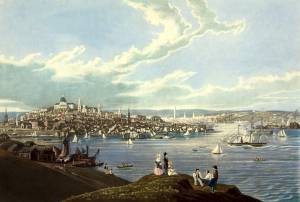
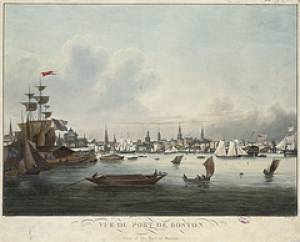

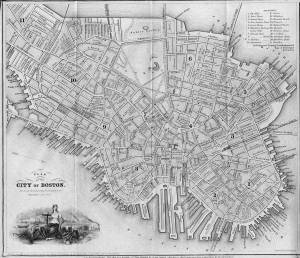
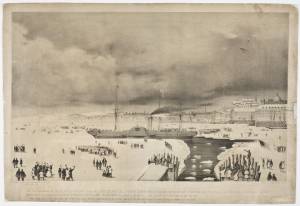

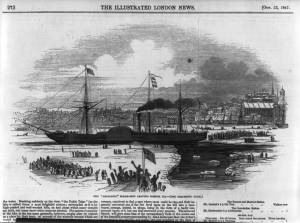

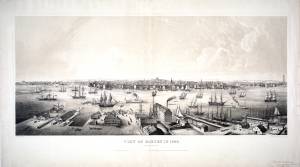


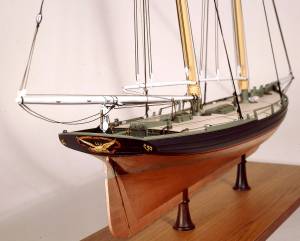











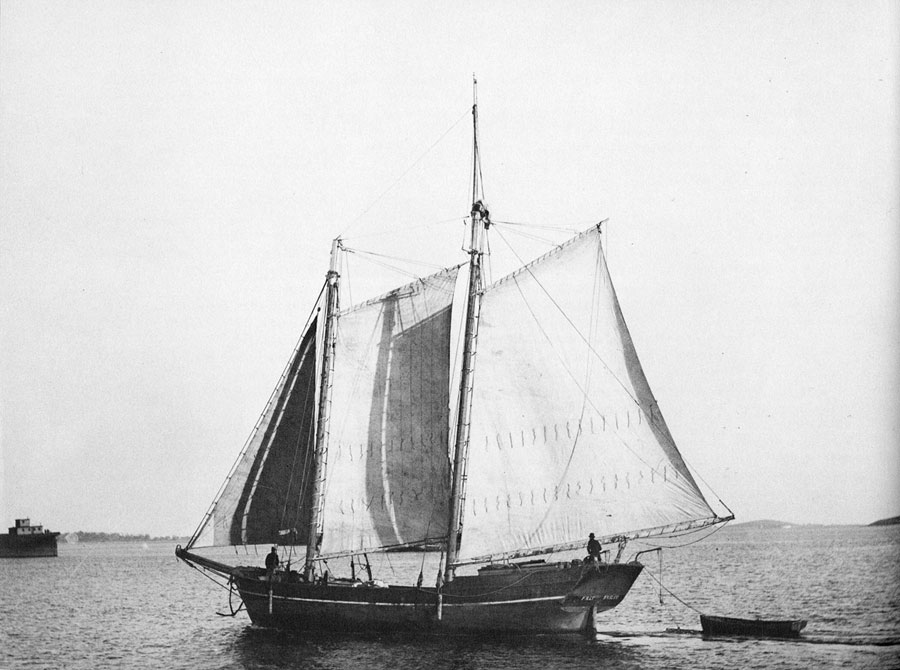
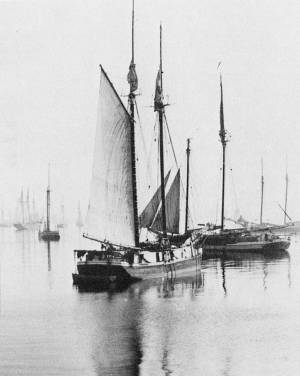


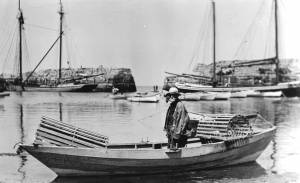
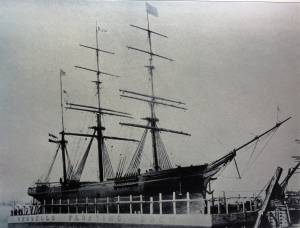
_sm.jpg)

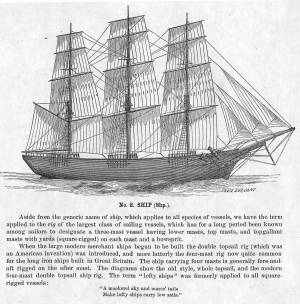
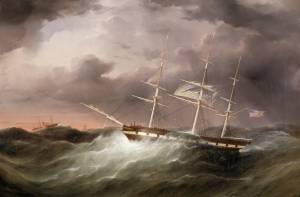

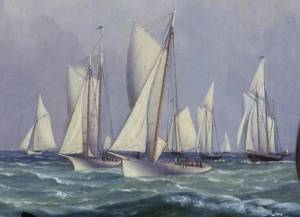
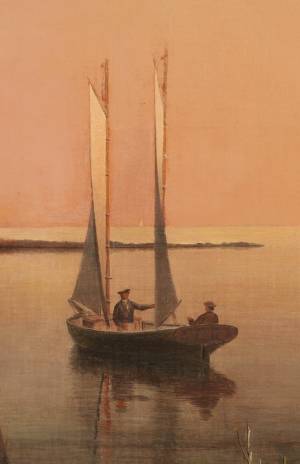



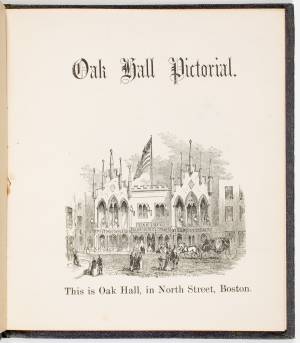
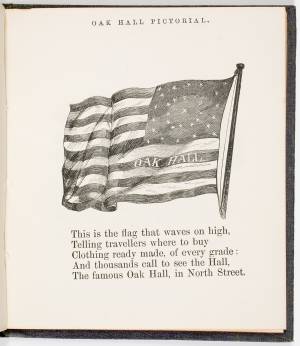



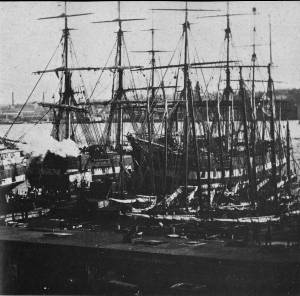
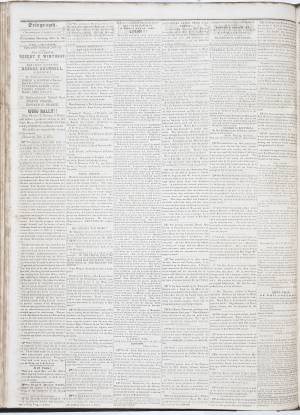

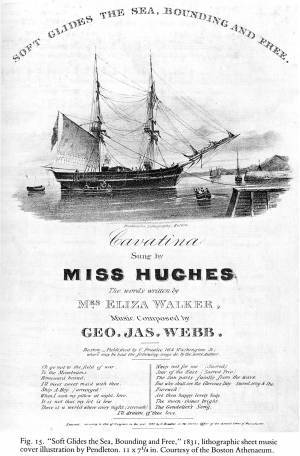
Commentary
Yachting in Massachusetts Bay is said to have begun in 1801, when the sloop “Jefferson” was built in Salem for Captain George Crowninshield. Pleasure cruising seems to have been yachting’s sole purpose in this region until the mid-1830s, when some schooners were built and used for racing, their hulls and rigs imitating those of fast pilot schooners.
In 1839, Colonel William P. Winchester commissioned Louis Winde to design "Northern Light," a schooner yacht of seventy register tons, which was built at East Boston by Whitmore Holbrook. At first used for cruising, she was given longer spars and a larger sail plan in 1843, and started racing in earnest. In 1844, she sailed to Newport, Rhode Island, to participate in a regatta sponsored by the New York Yacht Club. Two years later, she sailed in that club’s second regatta at New York. At the end of 1846, she was sold for use as a packet, making scheduled sailings between Boston and Plymouth, Massachusetts. Winchester repurchased her in 1848, then sold her a year later, the new owners planning to sail her to California. En route, in 1850, she was wrecked in the Strait of Magellan with all hands rescued.
To judge from the composition, Lane has made little, if any, changes to the drawing by Robert Salmon that (according to the inscription on the reverse of the painting) was a source for the painting. Salmon’s harbor scenes were usually crowded with vessels of many types and sizes, and one or both ends of the foreground often contained vessels and wharves (or parts thereof) that framed activity in the painting’s center. Both Lane and William Bradford made use of this device, but only seldom, if surviving examples are any indication. The application of this effect by Lane can be seen in his vessel portrait "Starlight" in Harbor, c.1855 (inv. 249).
Another effect in this painting that Lane borrowed was to illuminate the sails of vessels in the foreground, leaving those in the background much darker to provide contrast and emphasize foreground subjects and activity. Lane’s paintings seldom used or needed this device to the extent that Salmon used it, as his harbor views were less congested with vessel traffic. In his Boston and New York harbor scenes, Boston Harbor, Sunset, 1850–55 (inv. 242) and New York Harbor, 1852 (inv. 345) are examples of his way of employing contrast in ships’ sails.
– Erik Ronnberg
[+] See More